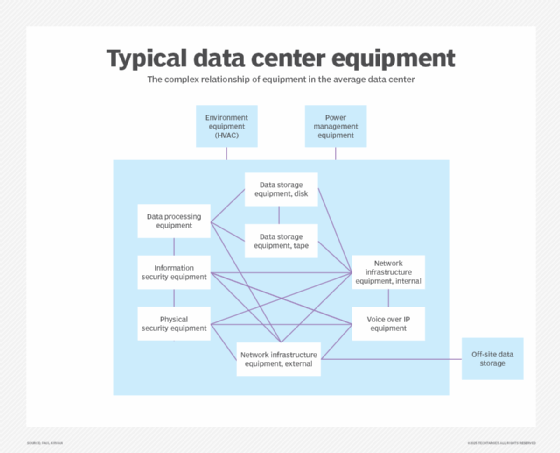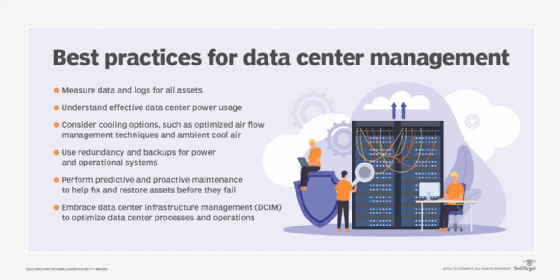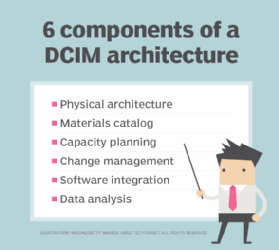Top data center infrastructure management software in 2025
DCIM tools can improve data center management and operation. Learn how six prominent products can help organizations control costs, manage energy and track assets.
The data center market is continually evolving, necessitating data center infrastructure management software to adapt accordingly. DCIM tools are now a necessity for most data centers, as managing complex computing operations -- often with far-flung segments -- can quickly overload the human ability to process.
The DCIM industry is projected to grow to $5.01 billion by 2029, according to research from MarketsandMarkets. DCIM is considered so essential that ASHRAE published a book titled Advancing DCIM with IT Equipment Integration as part of its Datacom series.
What is DCIM?
Despite the widespread adoption of DCIM, users remain confused regarding its purpose and functionality.
In general, DCIM is a software suite for managing data center infrastructure and the resources it uses. DCIM tools collect data from IT and facilities, consolidate it into relevant information and report it in real time. This enables the intelligent management, optimization and future planning of data center resources, such as capacity, power, cooling, space, network and assets.
Vendors might incorporate all or some of the following categories that fall under this definition:
- AI and machine learning optimization.
- Network management and optimization.
- Centralized and remote monitoring.
- Energy and environmental monitoring.
- Asset and workflow management.
- Event reporting and management.
- Structured cable management.
- Data center visualization.
- Capacity planning and what-if scenarios.
Before adopting DCIM tools, vendors recommend doing the following:
- Determine which aspects of your operation most benefit from improved information. Limit to one or two areas; more than three is probably overextending. Trying to do too much at once is the leading cause of product dissatisfaction and failure.
- Concentrate on offerings that advertise those functions and features. Get trial versions of the two or three tools that best fit your needs. See how easily they can be implemented and how intuitive they are to use. If asset auditing and tracking are essential, look critically at how this is accomplished and how realistic the approach is for you.
- Speak with existing customers to get firsthand feedback on their experiences. This also helps you understand what it takes to be successful.
- Consider a modularly expandable product if you anticipate broader future needs. However, be sure it can integrate the useful resources you already have. Add capabilities only when you have learned to maximize the value of what you have. That might mean adding to your initial package or acquiring another compatible product that better addresses those additional goals.
- Ensure you can allocate staff resources to implement and maintain the selected product. Budget for customization, which is usually necessary, or hosted monitoring, which you might want. DCIM products are essentially database management systems. They can be configured to do many tasks automatically but might require manual data input to keep them up to date.
- Examine vendor training programs. Are they done once or continuously? What is the added cost if you need additional training?
- Fully evaluate what is required to secure an acceptable ROI on your DCIM project investment.
- Evaluate security. This remains critical with all DCIM products, but simply restricting to one-way communication might be too simplistic. Data center power usage and temperature are probably useless to a bad actor. However, obtaining the IP address, DNS information and the router's network path could be beneficial to a hacker. Security requirements can be different for each business. Take a close look, particularly with cloud-based services.
DCIM products
The six DCIM products outlined here -- in alphabetical order -- are all in tune with market drivers and strive to provide real-world benefits in increased reliability and reduced operating costs.
Cormant-CS
Cormant-CS, BGIS's leading DCIM product, is used in data centers, colocation sites and IoT deployments, catering to various hybrid customer needs.
Infrastructure management data is a shared resource, so Cormant-CS supports full, multiprotocol network query and discovery, with automatic association, update and linking. Multiple two-way API-to-API services support complex integrations, all delivered with a UI for an extract, load and transform service supporting deep integration.
Some options include a configuration management database, IT service management, ticketing, vendor supply, purchasing, financial asset management, flat-file, direct SQL, virtual device and cloud management platforms. A modern RESTful API supports high-volume, two-way integration for customer-built integration.
Cormant-CS monitors devices and provides real-time data on power, environment and capacity. It features Albums for storing documents and images linked to specific locations or devices.
Search functions are integrated for user convenience, enabling real-time filtering of data like floor plans, racks, alerts and tasks. Starting pages feature graphical Health Cards for quick, user-defined views of racks, devices and sites. Data analysis identifies environmental changes and their causes. Mobile devices can access data online or offline through integrated barcode scanning.
AI is being introduced where it can help customers maximize facility utilization and reduce stranded network capacities. Initial implementation simplifies change request creation and offers location and connectivity suggestions. The AI offering is designed for cloud and on-premises installations with no contact outside the enterprise.
Cormant-CS includes support for online and offline mobility, ensuring users have access to records in the field and can record moves and changes as they occur. Instant documentation ensures records are accurate and can be trusted while a technician is making the change. Full support for barcoded assets and cables ensures that data entry is as fast and accurate as possible.
The software includes highly granular role-based security, with Active Directory and Lightweight Directory Access Protocol integration and end-to-end application encryption. Cormant-CS has been delivered to multiple military and financial institutions, including the U.S. Department of Defense's Security Technical Implementation Guides.
Cormant offers customer-specific planning, project management, consulting, integration and training services for global deployment with various licensing models and price tiers. It also provides migration tools to support Trellis users since Vertiv discontinued its DCIM platform. There are now processes to support migration from other assets and DCIM software.

EkkoSense
EkkoSense became a prime DCIM vendor with EkkoSoft Critical, its data center performance optimization software. EkkoSoft Critical is based on more than four years of research into how AI could provide useful interpretation of the myriad data derived from data center power and cooling systems. EkkoSense has operations in the U.K., Europe, U.S. and Australia, along with a rapidly growing global partner network.
EkkoSense added AI and machine learning technology to the traditional monitoring and alerting services to improve data center operations. EkkoSoft Critical data center software provides comprehensive monitoring, evaluation and capacity management capabilities, as well as operational visibility that can lead to lower thermal and power risks. Data center cooling energy costs and carbon reductions all help meet corporate environmental, social and governance (ESG) requirements. Additionally, EkkoSoft Critical now features embedded ESG reporting, which automates the production of ESG and sustainability reports required by the EU since Jan. 2024.
EkkoSense wireless sensors can be fixed to cabinets and placed in cooling units. Alternatively, existing sensors can be accessed and supplemented by EkkoSense wireless sensors where necessary. All data points are sampled every five minutes, and the effects of changes are analyzed by the AI and machine learning engine. The result is a dynamic picture of the cooling Zones of Influence -- in other words, which cooling units provide most of the cooling to each cabinet and how well they do it.
Based on this data, plus integrated asset management details, total rack power data and other room measurements, the software delivers graphic illustrations of how the room cooling system operates. It also shows the amount of power usage per cabinet versus available power and then provides specific instructions for making the best adjustments to the cooling system. EkkoSoft Critical can also integrate with other leading DCIM platforms, combining monitoring and evaluation data with IT asset data to enable a broad DCIM functionality.
Cooling systems are the largest energy users in a data center, next to IT equipment, and are the prime focus of this targeted software. Based on measurements at multiple installations, EkkoSense stated that it has achieved actual cooling energy reductions averaging 30% and has released up to 60% of stranded cooling capacity.
FNT Software
FNT is an established software company that has been supporting web-based tools and virtual, cloud and hybrid digital DCIM platforms for more than 25 years. FNT concentrates on seven main areas: asset and lifecycle management; structured cable management; connectivity management; network management and optimization; visualization; workflow; and capacity planning and reporting.
FNT documents data center infrastructures and stores the data in FNT Command, which acts as a digital twin of the infrastructure. FNT has optimized its visualization functionality to advance this concept and bring the data center representation closer to how its real-world counterpart looks and behaves. The software features new capabilities and a 3D footprint viewer, which makes working with critical infrastructure data easier.
Recent software enhancements fall into three categories:
- Visualization. Visualization functionality includes a redesigned 3D display and a heat map feature to deliver a realistic look and feel of the rooms and equipment. This is a major advantage when remotely managing sites. Improved performance and an intuitive usability concept -- harmonized with common augmented reality and virtual reality formats for mobile platforms, such as USDZ -- model behavior and control, enabling users to easily adopt these tools.
- Workflow. In addition to the existing workflow module, FNT provides a more powerful Business Process Modeling Notation-driven alternative for complex workflows, including exception handling and work order management. FNT ProcessCenter is particularly beneficial when a high degree of standardization, transparency, planning and orchestration is needed to integrate provisioning and change processes. This operates from initial requests to the commissioning of equipment.
- Integration. Enhanced integration capabilities make moving data between FNT Command and other applications faster, easier and more accurate. This is arguably the most business-critical enhancement to the software. Its low-code/no-code design uses a GUI and drag-and-drop functionality so users can create and adjust interfaces between systems. FNT's software is standard off the shelf, but its new FNT IntegrationCenter makes it easily adjustable to suit the specific needs of individual integration scenarios.
FNT's software differentiates itself with its proactive event-driven API capability. Rather than relying on batch or bulk data processing, FNT Command recognizes when there's been a change and sends a change notice to event subscribers. This real-time data exchange ensures the most accurate and current information is always available for analysis and decision-making.
FNT has also repackaged its software to be more modular and in line with users' needs. The default licensing is per user, independent of the number of racks or the size of sites. It also offers perpetual licenses and subscription-based licensing. FNT Command is cloud-ready and has a variety of installation options.

Nlyte Software
Nlyte Software, part of Carrier Global Corp., offers the Integrated Data Center Management initiative. The DCIM offering integrates Automated Logic's WebCTRL building automation system with Nlyte's Asset Optimizer to enable asset management and monitoring, as well as control of security, cooling and lighting systems in one package.
Part of Nlyte's approach is to participate in customer strategy teams to better tailor its products to specific industry and customer needs. The Nlyte product adapts to a wide range of operations and facility sizes. These include conventional enterprise DCIM monitoring, colocation facilities where capacity forecasting is challenging, cloud services where asset management requires metrics to know where to run workloads, edge computing sites spanning cell towers and data centers in a rack.
Accurate information is also necessary for sustainability reporting. This is a significant and growing requirement for many operations, and Nlyte has introduced a new offering specifically providing sustainability measurements and reporting.
Nlyte monitors and optimizes the cooling chain for efficiency and availability. Precise thermal measurements are necessary to maximize cooling, which requires dense monitoring for accurate insight. Because cooling systems are mechanical, they require the most maintenance and experience the most critical events. Nlyte has focused on the correlation between cooling systems and applications to detect anomalies and forecast behaviors of critical infrastructure and IT systems.
Schneider Electric EcoStruxure IT
Schneider Electric's DCIM software, EcoStruxure IT, ensures business continuity by enabling secure monitoring, management, insight, planning and modeling. The software is vendor-neutral to maximize customer flexibility and ROI. Packages include cloud-based EcoStruxure IT Expert, backed by Microsoft Azure, and on-premises Data Center Expert. Both access operational data; provide real-time monitoring of Schneider Electric and third-party devices; and deliver user-defined reports, graphs and instant fault notifications.
Schneider's advanced DCIM software reduces Opex and downtime by gaining real-time insight into colocation, enterprise data centers or distributed IT sites. The DCIM software can be cloud-based or on-premises, providing device management for power and cooling devices, as well as physical and environmental security monitoring.
In addition, EcoStruxure IT Expert's data analytics provides actionable information on status, alarms and infrastructure health. This includes predictions of battery life, status updates, security analytics -- such as out-of-date security certificates -- and whether standard usernames and passwords still exist. EcoStruxure IT Expert tracks protocol and current malware vulnerabilities, alerts to outdated firmware in monitored devices and provides the option to push updates using a secure IT gateway.
Schneider's proprietary NetBotz appliances and sensors can add physical and environmental security monitoring. They are also compatible with protocols such as Simple Network Management Protocol and Modbus TCP. Being vendor-agnostic, NetBotz integrates third-party and legacy systems and monitors connectivity for discovered devices.
NetBotz protects IT infrastructure against environmental threats like temperature and humidity deviations or smoke and water leak detection. Physical security provides integrated sensing, surveillance options and badged rack-access control.
EcoStruxure IT Advisor is on-premises and cloud-based software for planning, modeling and optimization. It provides full insight into data center or colocation infrastructure. The product delivers asset tracking, risk management, capacity optimization, workflow and device lifecycle management. It can integrate with management tools, such as ServiceNow, representing all equipment through a genome database.
Combining IT Expert and IT Advisor provides asset autodiscovery, wherever-you-go visibility, smart alarming and AI-driven load-balancing assistance. Both EcoStruxure IT tools are provided in cloud or on-premises versions, but Schneider Electric also offers two additional cloud-based tools.

EcoStruxure Asset Advisor service delivers third-party cloud-based monitoring and maintenance in two service levels: Prevent and Predict. Prevent delivers 24/7 remote monitoring service, alarm notifications and investigative support, live data using a mobile app, and monthly incident and status reports. Predict, when added to Prevent, provides data-driven expert insights, cybersecurity assessments, battery health status and semiannual reports.
Schneider Electric or partners can use a separate cloud-based data center computational fluid dynamics (CFD) tool in the design stage of a project to ensure sufficient cooling and improve energy efficiency. Years of data collection also enable cooling simulation that provides 90% accurate 3D thermal maps without sensors or CFD modeling.
Sunbird
Sunbird continues to provide its proven second-generation DCIM software, delivering asset, capacity, change, energy, environment, power and connectivity management for a large installed base of customers. The Sunbird software provides automation using integration with free bidirectional connectors that allow asset and ticket information to be updated between systems, such as ServiceNow, Jira, Cherwell and BMC. This level of integration reduces manual effort and increases data accuracy.
Sunbird's visualization capabilities turn data into actionable information. A world map presents health status and key statistics for all sites, with easy navigation and the ability to drill down to sites at a street level. High-resolution floor-map visualizations enable remote operations management with accurate 3D views that often make it better than being there, again with the ability to drill down for further detail. Users can isolate a row of cabinets to see front and back images of assets along with an augmented overlay of actual power loads, temperatures and humidity levels of cabinets.
Data network diagrams show core, distribution and access networks. Sunbird also automatically creates single-line diagrams for each alternative current and direct current (DC) power chain in a single interactive pane of glass. Details include utility feeds, fuel tanks, transformers, generators, switchgear, switchboards, automatic transfer switches, panelboards, uninterruptible power supply units, floor power distribution units, plants and DC bays with budgeted and actual values, such as voltage, current and power rating. The single-line and data network diagrams provide drag-and-drop edit capabilities and can be printed.
An enterprise-class multivendor power and environmental data collection engine lets users combine asset information with power and environmental measurements. Sunbird's patented Auto Power Budget feature automatically updates power budget values based on customer-defined policies, enabling the reduction of stranded power capacity.
The zero-configuration analytics dashboard and reporting capabilities include more than 100 charts. There are also free add-ons, which include an additional 150 charts that present performance indicators to manage the capacity of key resources, such as space, power, cooling and data ports. Chart examples include what-if analysis for space and power capacity, spare parts stock levels, remaining cabinet space, power distribution and redundancy, latest temperature per cabinet with Delta-T and power port capacity trends. Charts and reports can be automatically scheduled for creation and distribution, reducing the manual effort needed to generate the information.
Sunbird's service and support includes free weekly training, a modern support portal and a complete offer of services.
Editor's note: This article was updated in 2024 by the site editor. Extensive research was done, and updates on the information above were provided by specialists.
Robert McFarlane is a principal in charge of data center design for the international consulting firm Shen Milsom and Wilke LLC. McFarlane has spent more than 35 years in communications consulting and has experience in every segment of the data center industry.








